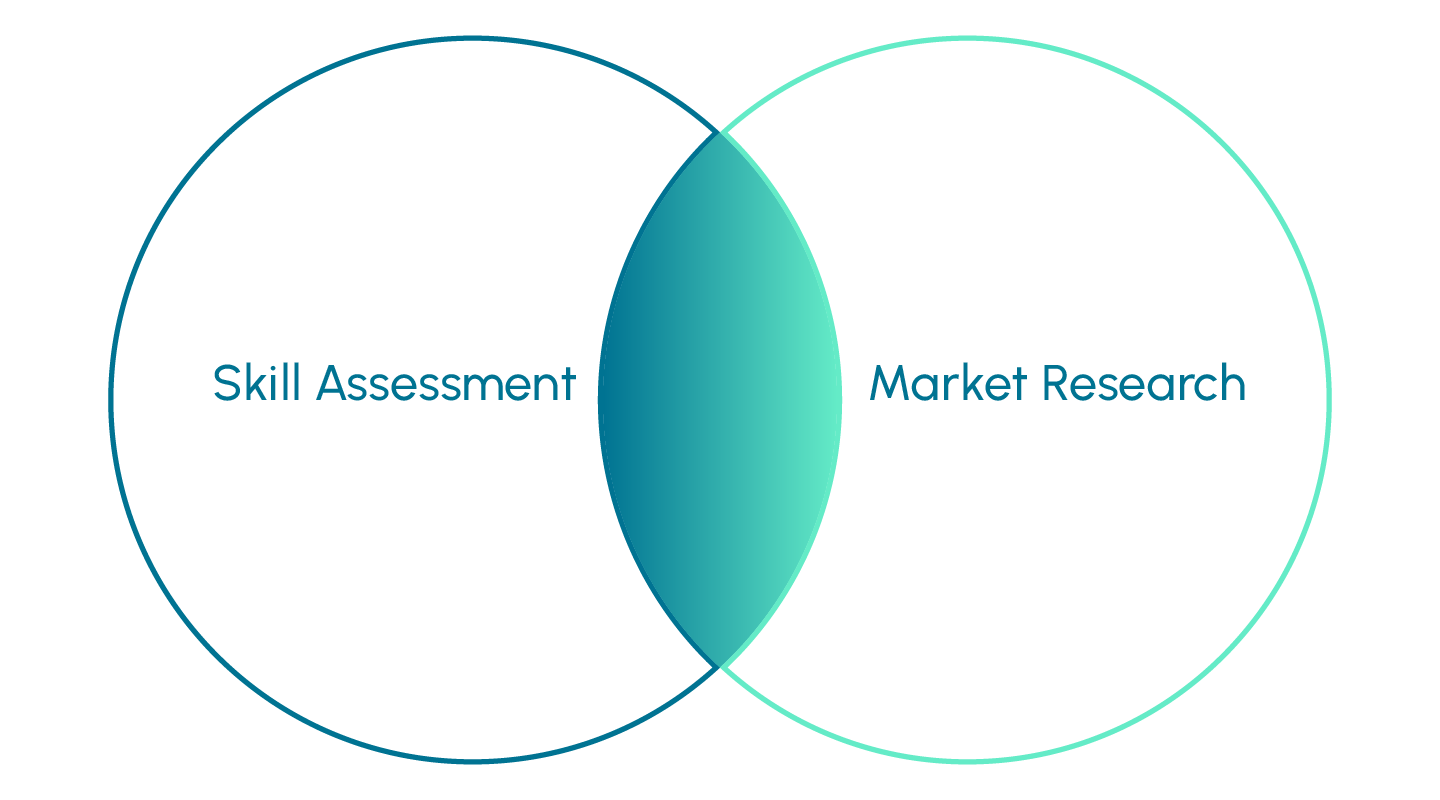How To Find Your Freelancing Niche With Convergence
Published on March 18, 2022
Written by David Potter

There is a practical way on how to find your freelancing niche that uses the traditional concept of convergence. The benefits to understanding this include:
-
Better understanding client needs/problems
-
Being seen truly as an expert (not just something that is said)
-
Higher contracts to proposals written ratio (more clients to less effort)
So let’s first understand what convergence is and how we make it simple so it can be easily applied to marketing to prospective clients. In the simplest sense, that will be further clarified, convergence for our purposes is similar to supply and demand.
When an individual or entity (business) has something that another individual or entity deems valuable we have convergence. We have a demand for a potential supply of whatever that something is. Essentially, freelancers want to offer a skill for a cost to someone else who wants the results of that skill. Convergence is the overlap in the scenario like in the figure shown.
The idea has been broken down to simplicity, but how can we use this to find a niche to stand out from competition and better spend our time writing high-quality and focused proposals to clients? Let’s follow some simple steps that you’ve probably heard before but were too abstract to know how to take action on them.

1. Self Assessment
The very first thing you should do is take 5 to 10 minutes to think about all the skills, experiences, tools, and other resources that you currently possess or have access to. Write them out on a piece of paper without criticizing what you write down. Maybe you're thinking of doing freelancing in the category of graphic design. What skills do you possess? Where did you learn those skills? Did you take any courses? Do you possess any certifications? List out the places you worked and your job responsibilities (don’t limit it to your freelance category). What software or programs do you use? How good is your computer? How much time do you have to freelance each week? Write out as much as you can.
Following this exercise, you can reorder everything so it has some kind of logical organization if you like. You’ll likely add to this from time to time, and look at it to see what else you want to learn so you can add to the list. The goal is to go from “I want to be a freelance [graphic designer]” to understanding more about your strengths and unique experiences. There is only one you.
2. Market Research
There’s no reason to make this as complicated as it sounds or how you may have learned it previously. It’s beyond simple by implementing the tactic you’re about to learn. Whether you’re just starting out in freelancing or have struggled with getting enough clients over weeks or months, you have access to all the data you’re going to need.
What you need to do is go to freelancing platform websites like Upwork or Freelancer and search for jobs in your category. While conducting the search look at key pieces of information that you’ll best understand as someone skilled in your chosen category. Try to find about 20 - 30 job posts in your category that you would want to be hired for and you know most of what is required to complete the work. Print the page so you can save it as a pdf for future review. It may take you a few days to complete this very important part of the process, but it is worth it.
Like when you did the self-assessment, now you’re going to organize the data collected to assess potential overlaps. What you are looking for is a common thread of skills and tools required and how you are uniquely qualified to give the clients’ an above average result when delivering. Pay attention to client size, review ratings, money spent, and etc if you have access to the information. Sometimes an upgraded platform account is required to access that data. This information is powerful, so it might be wise to take advantage of a free trial period just to see this data.
3. Convergence
You may have already guessed, but if not, your next step is to try to match things up between you and groups of clients like puzzle pieces. Where do you best fit? Likely, you will find that you are really strong with some client groups that you can go after right away. However, you may also find a client group that you’d like to work with and you have some unique advantages, but you are weak in a couple of areas. That’s why this process is so crucial. You now know what niche you can immediately help, and/or you know what niche you can help if you strengthen up a couple of weaknesses.
That’s not really where this process ends for action steps, though. It’s great knowing this, but let’s use it so you can win some awesome freelancing clients. Your public profile should be speaking to a selected niche (client group). The words you use to the images you select to show should all speak to the idea “I’m the best [professional] to help [niche] clients”. Some of the words should be tribal, only well-known within particular industries or departments. The images should be of similar clients you’ve helped or conceptual to the niche.
Starting out, you’ll have to write some proposals to your selected niche, but you’re equipped with real data of what this niche truly wants. You look like a member of their tribe and speak their language. That’s exactly how you stand out from other freelancers. After you gain traction or reputation on a platform or you have clients that send you referrals, you will find things get much easier. You won’t feel like you’re hunting for your next meal. Instead, you’ll be harvesting what you planted a few short months ago.
Summary
We as freelancers can find a niche market to focus our efforts by understanding ourselves, understanding common client problems and requirements, and connecting the two together. This makes it much easier to show prospective clients that we are uniquely qualified to solve their problems and do so remarkably well. By finding convergence, we know how to recreate how people perceive us so they know that we are the expert that knows their problems well and we’ve solved it for others in the same situations.
As a final word of encouragement, please hear this advice. Sometimes we choose not to do things because they sound too simple. There’s many reasons for this, ranging from psychological perfectionism, to procrastination, to skepticism, to a “feeling” we did it in our mind so it’s already done. If you really want to make it as a freelancer, and not struggle as one, you really need to complete this process. Take the first step now; don’t promise yourself you’ll do it later.
A good recommendation for the length of a proposal should follow 3 rules.
-
The proposal should be at least 3 sentences.
-
The proposal should be no more than 3 paragraphs.
-
The proposal should not mention much about you and your skills.
The easiest way to figure out how much to write is to match approximately the length and effort the prospective client wrote the job post. This can be called chameleon writing in sales because it’s meant to blend and attempt to match the client’s personality type. Three sentences to three paragraphs is usually the norm, but none of it should include much about you unless it’s a simple sentence pointing the prospective client to your attached portfolio. Clients care about their problem being solved, that’s it.
Example of Effective Freelance Proposal
Freelancers Journey is meant to be industry agnostic so no matter the skills you may have, the material can be easily applied. The example used will be that of a job post meant for a graphic designer, but the post text and proposal text will be kept simple for ease of understanding. Sometimes job posts are this simple, but in most cases they are slightly more complex.
Job Post
“We are a veterinary company that specializes in working with dogs only. We need a graphic designer that is good at selecting photos for our website because we initially used free stock images, but we need something a bit more premium and customized. Looking forward to your proposal.
-Jan”
Proposal
“Hi Jan,
I’m interested in helping you select and optimize photos of dogs or other images that would reflect your veterinary business. I’d be happy to pull an appropriate selection that fits your brand and then optimize them for the website. Do you have specifications for pixel density or could you show me where on your website these images will be placed?
If you’re interested in working together on your project, let’s hop on a Zoom call at your earliest convenience.
Thank you,
Freelancer”
Points To Review
-
We knew Jan’s name from it being included in the job post and included it in the greeting
-
Our restating the problem included the key words of “dog images” and “veterinary” to show we read and understood the problem
-
Our proposed solution included that the images would be selected and optimized for the website which further demonstrates we understand the problem and can solve it
-
Our proposed solution also asked a question regarding specification to show we are skilled in solving problems like the one the potential client has
-
We also left a call to action to help the potential client make a decision to reach out to us and continue the process
-
We kept the proposal short and to the point.
-
We did not talk about ourselves at all.
Summary
Writing effective freelance proposals is done by engaging in a basic sales process. It requires recognizing someone else’s problem and writing it back to them to show that we understand. We have to write a simplistic solution that tells the prospective client we’ve solved this problem before or confident in our skills that we can solve theirs without needlessly telling them how great we are. Lastly, a call to action is included to increase the chances of a reply to our proposal. Writing high-quality and effective proposals will yield better results than simply writing a lot of them hoping for the best.